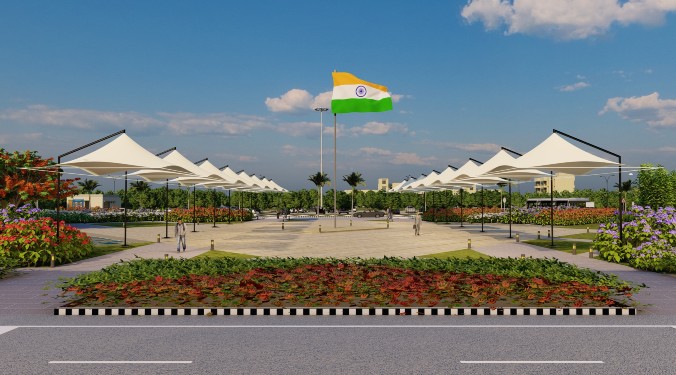“The profession [architecture] is getting acceptance, and it is likely to be more acceptable to masses in next five years,” says Architect Surinder Bahga
Ar. Surinder Bahga wears many hats. He is a councillor in Chandigarh Municipal Corporation (MC), the editor of the Journal of Indian Institute of Architects as well as completed three projects. In an exclusive interview with ACE Update, he talks about the profession and how he is working endlessly to solve various issues concerning Indian cities.
Architecture and IndiaIndia is one of the oldest civilisations with a kaleidoscopic variety and rich architectural heritage. Over the years, due to increase in population, poverty, industrialisation and growing materialism, we have lost track of achieving excellence in architecture. There was considerable deterioration in almost all spheres of life. Architecture was also at crossroads. Chandigarh offered the Indian architecture a great opportunity but that was 68 years ago. British architect Dame Jane Drew had said, “Unfortunately, no Indian politician since Nehru has really done much to use the talent available. France has benefited enormously from Mitterand’s patronage. The need for India is to use architects to solve its great housing and planning problems is self-evident”.
At the time of India’s partition in 1947, there were only two teaching institutions of architecture and about 300 qualified architects in the country to serve a population of 330 million. By the mid-80s, to a maximum stretch, only 10,000 architects were available for 750 million people which worked out to one architect for every 75,000 people ─ quite a low ratio as compared to the one prevailing in developed countries like the United States and the Great Britain. But today’s India teems, with about 400 schools of architecture, turning out almost 25,000 graduates every year. The surveys indicate that India needs nearly 6.5 lakh architects in next few years to meet the demand of the country. Surely the profession is getting acceptance, and it is likely to be more acceptable to masses in next five years.
Value additionWhen any profession grows, it leaves positive impact on any organisation. For example, with the growth of law, medicine and accountancy, lawyers, doctors and chartered accountants have benefited a lot. So Ar. Surinder Bahga expects if our architecture flourishes, the architects will automatically prosper.
At present only 2 per cent of India’s buildings are designed by architects, rest are still being done by unqualified people. Public can reach architects even at small towns or village level. There will be more opportunities and more options of hiring good professionals. There can be more competition provided it remains healthy one.
X-FactorsThe availability of a large variety of building materials, growth of building industry, technology, awareness about architecture in general and green buildings in particular are some of the X-factors which are helping the architecture, construction and infrastructure industry.
On the other hand, deteriorating level of architectural education and calling tenders from architects against the spirit of Architects Act, 1972, are factors which are bringing bad name to architectural profession. The Union Government and Council of Architecture may consider inviting good teachers from abroad to cope with the acute shortage of good faculty in the country. When private airlines were launched in India, government permitted airlines to hire pilots from abroad. Similarly, architectural faculty can be engaged from abroad. This can be experimented to lift the standard of education. Ar. Bahga observes, allowing foreign architects to practice in India should be allowed only on mutually accepted terms. For example, foreign architects can work in India but Indian architects are not allowed there. It is unfair.
Achievements in 2014Ar. Bahga had envisioned certain ideas and projects in the beginning of 2014. It gives a lot of satisfaction if one’s dreams get translated into reality. In 2014, he had completed three projects; namely, Red Cross Bhawan in Chandigarh, Red Bishop Convention Centre in Panchkula and Agro Mall in Rohtak. In these projects, he has made an attempt to relate these buildings to site and surroundings having concern for environment.
As a councillor in Chandigarh Municipal Corporation (MC), he played a key role in conceptualising and implementation of over bridge, underground multi-level parking and construction of MC head office in Sector 17 besides a school in sector 49 in Chandigarh. It is surely going to benefit the citizens in many ways and give a completed look to Le Corbusier’s commercial district of Sector 17.He had organised an International conference on Habitable Built Environment called “Niche-2014” at LPU, Jalandhar. It was the first such conference of this level in Punjab.
Expectations in 2015Ar. Bahga is involved in drafting Punjab Energy Conservation Building Code which is likely to be implemented in Punjab. Talks are going on with the Bureau of Energy Efficiency for training staff related to local bodies like municipal corporations and councils, improvement trusts and other stakeholders like architects, engineers, planners and builders.In his own projects, he is sincerely trying to design building envelope, HVAC, public health and electrical services to make them energy efficient. He is working on CT University, Jagraon in Punjab having 16-lakh-sq.-feet covered area. It is to be built up on 37-acre site. Buildings are kept high-rise to facilitate more parking at ground levels. Special care has been taken to facilitate phasing and future expansion of the campus. In another project of Town Centre at TDI City, Panipat, he has two pockets. One pocket consists of showrooms and shops while the other pocket will accommodate showrooms at lower levels and three multiplexes on upper levels.
In order to realise the dream of Prime Minister to build smart cities in country, he along with other prominent architects are organising National Conference on “Rediscovering Cities” to be held at the School of Architecture, MMU, Ambala (Haryana) on 10-11 April, 2015. Many leading professionals and eminent personalities will deliberate on various issues concerning Indian cities.
13
Cookie Consent
We use cookies to personalize your experience. By continuing to visit this website you agree to our Terms & Conditions, Privacy Policy and Cookie Policy.









